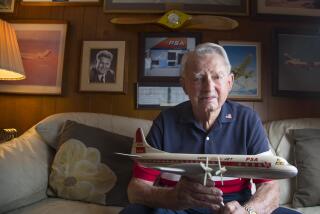PSA Flies With Cost-Cutting Plan : Airline Hopes Workers Will Begin to Think Like Owners
- Share via
After all the hoopla, after management’s threats that it would liquidate and after a fruitless standoff by a small group of reservations agents, PSA management has what it has sought for a year--a cost-cutting plan designed to return PSA’s airline operation to profitability.
The components of the cost-cutting are reduced pay and increased workloads, each a traditional bane of organized labor.
But in this case, there is a carrot: In exchange for a 15% pay cut and a 15% increase in workload, workers will be given 15% of the airline’s common stock and 15% of the airline’s annual pretax profits. Employees also will nominate four outside directors to be added to the airline’s nine-member board.
The caveat is that the workers will participate only in the airline operations--Pacific Southwest Airlines Inc.--not PSA Inc., the airline’s parent company.
That is an important element, because while the airline’s operation hasn’t been profitable since 1979, the parent company has been.
Using the profit-sharing formula--before taxes but after interest expenses--the airline lost a total $195.7 million from 1980 through 1983.
Parent Company Profitable
During that same period, PSA Inc. generated profits of $51.3 million, although that includes a $9.4 million loss in 1983. The earnings were garnered from other profitable operations, investment tax credits and depreciation.
With both pay cuts and increased production scheduled to be implemented this week, however, costs will decrease, and that will help the bottom line.
If workers begin to think like owners, then the company could regain its below-industry-average operating costs position, reasons Paul C. Barkley, the PSA president and chief executive. “Every employee now will have a stake in our success,” he said.
Had the pay-cut proposal started in 1984, Barkley said, the airline’s operations would have been profitable over the last 12 months. As it is, the airline’s operating loss through Nov. 30 was about $12 million.
Substantial Savings Expected
Moreover, Barkley said PSA may save between $15 million and $20 million in labor costs during 1985, with the potential of saving an equal amount because of increased production levels.
So while the past may cast a shadow over the newly approved profit-sharing plan, the future may hold reason for optimism.
Indeed, because of the plan, PSA will be able to take delivery of 15 additional fuel-efficient BAe-146 aircraft during 1985, increasing its total fleet of DC-9s and BAe-146s to 50.
Had the plan not been approved, PSA would have had trouble financing delivery of the new planes, Barkley said last week.
Planes to Cut Costs
The new planes will eventually mean more employees, more flight routes and new cities within PSA’s system, Barkley added.
The new planes will also dramatically cut PSA’s operating costs. The old PSA 727 workhorse cost $2,943 per hour to fly. The newer DC-9 Super 80 costs $2,271 per hour while the BAe-146 costs $1,691 per hour.
Those costs, about 50% of which are labor-related, do not include the 15% pay cuts approved by workers last week.
Those figures give PSA management hope that 1985 may be profitable, although, when pushed, they hesitate to predict a return to black ink this year.
In 1984, PSA approached the break-even point. For the nine months ended Sept. 30, PSA reported a net loss of $716,000 on revenue of $520 million. That compares to a net loss for the nine months last year of $5.4 million on revenue of $396.5 million.
Approval of the plan by the end of December was important, because management wanted to issue the first 5% chunk of employee stock during 1984, Barkley said. By waiting for approval in January, he said last week, the stock price would rise as the company becomes profitable--making the issuance more costly to the company--and the process would be dragged out until 1987.
Barkley backpedaled slightly at a news conference Friday from his earlier threats to either reduce service, convert to an airline-leasing operation or liquidate if employees rejected the plan.
Asked what would have happened had the company’s reservation agents not reversed their rejection Thursday, Barkley said that the plan eventually would have been started without those workers’ approval. The implication was that some type of work action against the agents would have been taken had they vetoed the plan.
The approval process was not without some management concessions, however.
First, to induce speedy approval, management offered each worker six additional shares of airline common stock if the plan were OKd before year’s end.
Secondly, Barkley acknowledged that “there was a feeling of ill-will” among some employees. Management not only gave workers a chance to air their grievances, but also took steps to solve them.
“The reservation agents had a lot of things on their minds about the ways things were run,” Barkley said. “We’ve been taking steps to resolve what they perceived as problems.”
Among the remedies was hiring a new manager of the reservations center, Barkley said.
More to Read
Inside the business of entertainment
The Wide Shot brings you news, analysis and insights on everything from streaming wars to production — and what it all means for the future.
You may occasionally receive promotional content from the Los Angeles Times.










